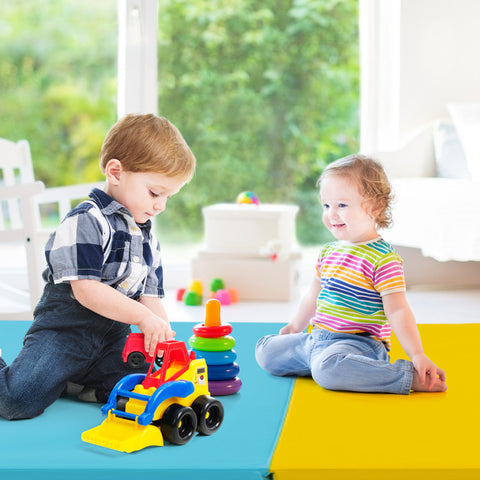News
Moisture-Wicking Technology in Gymnastics Mats: The Hidden Feature That Enhances Athlete Performance
Most athletes talk about cushioning, firmness, or durability when choosing a gymnastics mat. However, one feature is quietly redefining high-performance training environments: moisture-wicking technology. This characteristic, inspired by athletic apparel, is now making its way into professional gym mats to improve grip, hygiene, traction consistency, and overall safety.
While traditional mats rely on simple vinyl or foam surfaces, moisture-wicking mats focus on managing sweat, humidity, and surface dampness, essential for preventing slips and maintaining optimal hand and foot stability during intense routines.

What Is Moisture-Wicking in Gymnastics Mats?
Moisture-wicking is the ability of the mat's surface material to pull sweat and moisture away from the top layer and disperse it across the material so it evaporates faster. Unlike absorbent fabrics, moisture-wicking surfaces do not trap liquids. Instead, they redirect moisture to outer layers or microscopic channels, keeping the surface dry during training.
Modern moisture-wicking mats use specially engineered microfiber blends, hydrophobic coatings, or layered textiles that work in combination with EVA foam for performance stability.
Why Moisture-Wicking Technology Matters in Gymnastics Mats
Maintaining a dry surface is essential in a sport where grip determines safety. Even small amounts of sweat can reduce hand traction during handstands, tumbling, rolls, or balance drills. Moisture-wicking mats play a crucial role in keeping the training space safe and predictable.
Moisture-wicking mats also reduce odor buildup. Sweat creates breeding grounds for odor-producing bacteria, but rapid evaporation limits bacterial growth and improves long-term hygiene.
They also provide consistent grip for all athletes. Regular mats may become slippery for athletes who sweat more or during longer sessions. Moisture-wicking mats maintain equal traction for everyone on the surface.
Humid environments benefit greatly. In areas with high humidity, mats can accumulate surface dampness. Moisture-wicking designs prevent this.
These mats also support skin comfort. Dry, clean surfaces reduce friction burns and irritation, especially during floor exercises or stretching.
How Moisture-Wicking Mats Work: The Technology Behind the Surface
Moisture-wicking mats incorporate multiple layers and textiles engineered to manage sweat efficiently. They typically use directional fiber structures that move moisture outward, micro-channel surface patterns that spread sweat thinly for faster evaporation, hydrophobic surface coatings that prevent liquid from pooling or sticking, breathable top layers that allow air to circulate through the material, and dual-layer systems where the top textile disperses moisture and the foam base maintains shape.
Many premium gymnastics mats now use textile science concepts previously found only in sportswear, yoga towels, and performance training gear.
Signs You Need a Moisture-Wicking Gymnastics Mat
Your current mat may need an upgrade if you notice surface slickness during workouts, musty odor despite regular cleaning, sweat patches that stay visible for long periods, uneven grip during extended training sessions, athletes pausing to dry hands frequently, or mats becoming slippery in humid or warm environments.
If any of these occur, moisture-wicking technology can significantly improve training conditions.
Ideal Users for Moisture-Wicking Gymnastics Mats
Moisture-wicking mats are especially beneficial in professional gymnastics schools, high-intensity tumbling environments, home gyms without ventilation, summer training camps, coastal or humid regions, multi-user training floors, and fitness centers where mats are used continuously throughout the day.
Gyms with large student groups benefit the most since different athletes produce varying levels of moisture, making grip inconsistency a challenge.
Benefits of Moisture-Wicking Mats Compared to Standard Mats
Moisture-wicking mats deliver a noticeable difference in performance quality. They keep the surface dry even during long sessions, maintain significantly better hygiene, and reduce odors. The material remains less slippery, minimizing potential accidents. These mats promote better foot and hand grip, especially during flips and transitions. They also improve comfort during prolonged floor exercises and help extend the lifespan of mats by minimizing moisture damage.
How to Maintain a Moisture-Wicking Gymnastics Mat
Although moisture-wicking mats are designed for better hygiene, proper care maximizes their performance. Clean the surface daily with mild soap and water, avoid saturating the textile layer during cleaning, allow the mat to fully air-dry after each use, keep the mat in a ventilated space, avoid harsh chemicals that may degrade coatings, and store the mat flat or loosely rolled to prevent textile stress.
With proper care, moisture-wicking mats maintain efficiency for years.
Are Moisture-Wicking Mats More Durable?
Yes. Because moisture doesn’t penetrate the inner foam, the mat retains its shape longer. Additionally, the absence of trapped sweat reduces microbial growth, preventing material breakdown. Moisture-wicking textiles are typically more tear-resistant because they are engineered with performance fibers rather than standard vinyl.
Conclusion
Moisture-wicking technology is one of the most advanced developments in gymnastics mat engineering. By managing sweat, humidity, and surface dampness, these mats provide a safer, cleaner, and more stable training environment. Whether you're a coach, athlete, or gym owner, upgrading to a moisture-wicking mat is an investment in performance, hygiene, and long-term durability.
As gymnastics training becomes more demanding, the right surface can make all the difference—and moisture-wicking mats offer a level of consistency and safety that traditional mats simply cannot match.
FAQs
Do moisture-wicking gymnastics mats absorb sweat?
No. They disperse moisture instead of absorbing it, preventing odor buildup.
Are moisture-wicking mats suitable for children?
Yes. They provide better hygiene and grip, making them ideal for beginners and young athletes.
Do these mats feel different from normal mats?
They feel slightly softer or more textile-like, but the underlying foam firmness is the same.
Can I use a moisture-wicking mat outdoors?
Yes, but it should be kept dry after use to maintain textile integrity.
Are moisture-wicking mats washable?
The surface can be cleaned easily, but they should not be machine-washed. Spot cleaning and air drying is recommended.

